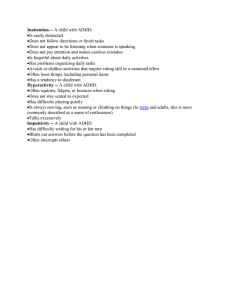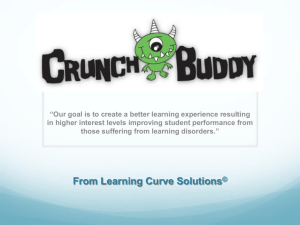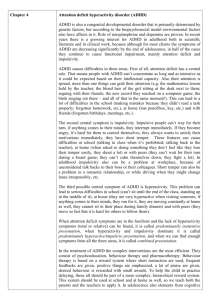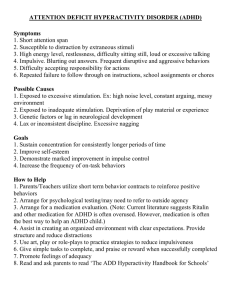Dealing with Impulsive Behaviors
advertisement
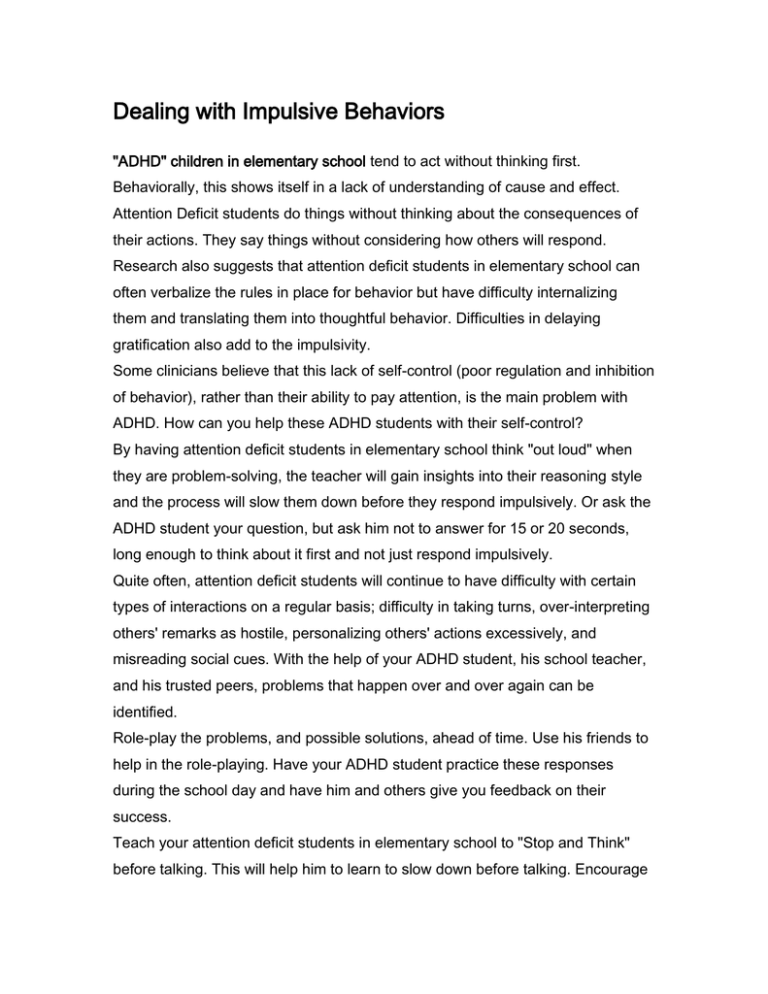
Dealing with Impulsive Behaviors "ADHD" children in elementary school tend to act without thinking first. Behaviorally, this shows itself in a lack of understanding of cause and effect. Attention Deficit students do things without thinking about the consequences of their actions. They say things without considering how others will respond. Research also suggests that attention deficit students in elementary school can often verbalize the rules in place for behavior but have difficulty internalizing them and translating them into thoughtful behavior. Difficulties in delaying gratification also add to the impulsivity. Some clinicians believe that this lack of self-control (poor regulation and inhibition of behavior), rather than their ability to pay attention, is the main problem with ADHD. How can you help these ADHD students with their self-control? By having attention deficit students in elementary school think "out loud" when they are problem-solving, the teacher will gain insights into their reasoning style and the process will slow them down before they respond impulsively. Or ask the ADHD student your question, but ask him not to answer for 15 or 20 seconds, long enough to think about it first and not just respond impulsively. Quite often, attention deficit students will continue to have difficulty with certain types of interactions on a regular basis; difficulty in taking turns, over-interpreting others' remarks as hostile, personalizing others' actions excessively, and misreading social cues. With the help of your ADHD student, his school teacher, and his trusted peers, problems that happen over and over again can be identified. Role-play the problems, and possible solutions, ahead of time. Use his friends to help in the role-playing. Have your ADHD student practice these responses during the school day and have him and others give you feedback on their success. Teach your attention deficit students in elementary school to "Stop and Think" before talking. This will help him to learn to slow down before talking. Encourage thoughtful responding and decrease impulsivity by waiting 10 to 15 seconds to receive responses during whole group instruction. Keep the classroom behavior rules in elementary school simple and clear. Have the class agree on what the rules should be. Define and review classroom rules each day. Implement a classroom behavior management system. Actively reward the behaviors that you want the students to do. Focus on the positive. Use a kitchen timer to indicate periods of intense independent work and reinforce the class for appropriate behavior during this period. Start with brief periods (5-10 minutes) and gradually increase the period as the class demonstrates success. When necessary, develop contracts with an individual student and her/his parents to reinforce a few specific behaviors. Set hourly, daily, weekly, or monthly goals depending on the reinforcement needs of the ADHD student. Provide frequent feedback on the attention deficit student's progress toward these goals. Provide a changing array of backup rewards or privileges so that ADD ADHD students do not "burn out" on a particular system. For example, students can earn tickets for a daily or weekly raffle for the display of positive behavior. To improve out-of-the-classroom behavior, allow the class to earn a reward based on he compliments they receive on their behavior from other teachers, lunchroom staff, playground aides and principals. Avoid giving the whole class negative consequences based on the ADHD child's behavior. The Attention Deficit child, as well as the whole class, can benefit from implementation of social skills curriculum for the entire class. Modeling and requiring the children to use a systematic method of talking through classroom conflicts and problems can be particularly valuable for the ADD ADHD child. Praise specific behaviors. For example, "I like how you wrote down all your assignments correctly," rather than, "Good boy!" Use visual and auditory cues as behavioral reminders. For example, have two large jars at the front of the room, with one filled with marbles or some other object. When the class is behaving appropriately, move some marbles to the other jar and let the students know that when the empty jar is filled they can earn a reward. Frequently move about the room, manage by "walking around." When you catch your ADD ADHD student working on-task, reward him with a simple wink or smile. "I like the way that you are working hard" goes a long way with Attention Deficit students. With students who can be quite volatile and may initially refuse negative consequences (such as refusing to go to time-out), set a kitchen timer for a brief period (1-2 minutes) after refusal has occurred. Explain to the child that the child can use the two minutes to decide if she/he will go to time out on her/his own or if more serious consequence must be imposed. Several experienced teachers insist this method has successfully reduced the extent to which they have had to physically enforce certain negative consequences with students and seems to de-escalate the situation.
